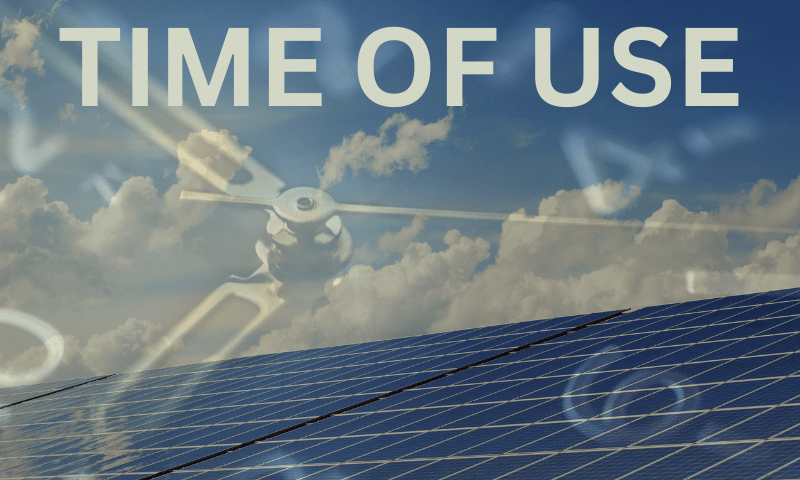
On this page
As electricity demand continues to rise in Australia, utilities are looking for ways to incentivise homeowners to reduce their energy use during peak hours. One strategy they use is Time of Use (TOU) rates, encouraging consumers to shift their energy consumption away from peak periods when electricity is more expensive.
Energy Matters has been a leader in the renewable energy industry since 2005 and has helped over 40,000 Australian households in their journey to energy independence.
Let us discuss and choose the best quote that suits your needs and budget, and we can connect you with our trusted local installers, who will provide up to 3 FREE quotes for your home and business solar energy system. Get your free quotes today!
Time of use tariffs/rates
A tariff is how you get charged for the amount of electricity or gas you consume in the energy industry. The variable portion of your bill fluctuates depending on how much energy you use. There are various sorts of tariffs for electricity, known as billing rates.
A time of use tariff (or TOU tariff) is a billing rate in which the price of energy varies during the day and is usually determined by the level of demand. As a result, TOU tariffs are often referred to as interval tariffs.
A TOU tariff is typically made up of peak and off peak time periods, though alternative time periods, such as shoulder and super off peak time periods, may be available. TOU electricity is commonly:
- Cheaper during off-peak hours, when electricity consumption is typically low.
- When there is a high demand for electricity, it is more expensive during peak hours.
You must have a smart meter to take advantage of peak and off-peak use hours on a time of use rate. Even if you have a smart meter and your electricity retailer offers a time of use rate, you will be charged for two separate charges: a usage charge and a supply charge. A time of use tariff only applies to your energy bill’s consumption charge element. You should only be on a time-of-use energy tariff if you have made a conscious decision to do so.
What is an electricity usage charge?
An electricity usage charge, also known as a consumption charge or variable charge in the past, indicates the cost of electricity used in your home. In other words, it is the amount you pay for each unit of power consumed by your home on a daily basis. Each kWh is totalled and calculated for your next monthly or quarterly statement.
What is an electricity supply charge?
While supply charge is now the most commonly used term to describe this cost, it was previously known as:
- Fixed Charge
- Daily Supply Charge
- Service Charge (or Service to Property Charge)
The supply price is not related to your usage; rather, this figure on your statement is a daily fee charged by your energy provider to your property for being connected to the network. Even if you consume no electricity during a billing month, this rate will be taken as long as your supply is connected. If you’ve ever gone away for a few weeks and returned home to a big electricity bill, this is for you. Most likely, the main cause is your daily supply charge.
Peak and off peak times
The times from AGL, Origin Energy, and EnergyAustralia are mentioned below. If you have a different retailer, you can learn about their peak and off-peak use hours and their prices by reading their energy price fact sheets.
NSW electricity peak and off peak times
| Peak | Off peak | Shoulder | |
| AGL | 2pm to 8pm, Mon-Fri | 10pm to 7am, Mon-Sun | 7am to 2pm and 8pm to 10pm, Mon-Fri | 7am to 10pm, Sat-Sun |
| Origin Energy | 2pm to 8pm Mon-Fri | 10pm to 7am, Mon-Sun | 7am to 2pm and 8pm to 10pm, Mon-Fri | 7am to 10pm, Sat-Sun |
| EnergyAustralia | 2pm to 8pm, Mon-Fri (summer) | 5pm to 9pm, Mon-Fri (winter) | 10pm to 7am, Mon-Sun (all year) | 7am to 2pm and 8pm to 10pm, Mon-Fri (summer) | 7am to 5pm and 9pm to 10pm, Mon-Fri (winter) | 7am to 10pm, Sat-Sun (all year) |
VIC electricity peak and off peak times
| Time of use tariffs are handled differently in Victoria. As with single-rate electricity tariffs, the state also provides customers with a default offer known as the two-period time of use Victorian Default Offer. This means that, in addition to price, Victoria’s peak and off-peak electricity timings are set as the default for each retailer on the state’s distribution network. Victoria has five energy distributors: Citipower, Jemena, Powercor, AusNet Services, and United Energy Distribution. The default peak and off-peak times for all Victorian energy providers on these networks are mentioned below. | ||
QLD electricity peak and off peak times
| Energex is the only energy distribution network for residential consumers in south east Queensland. With this in mind, Energex and your energy provider will determine peak and off-peak electricity times in Queensland. Consider the following peak and off-peak times for AGL, Origin Energy, and EnergyAustralia. | |||
| Peak | Off peak | Shoulder | |
| AGL | 4pm to 8pm, Mon-Fri | 10pm to 7am, Mon-Sun | 7am to 4pm and 8pm to 10pm, Mon-Fri | 7am to 10pm, Sat-Sun |
| Origin Energy | 4pm to 8pm, Mon-Fri | 10pm to 7am, Mon-Sun | 7am to 4pm and 8pm to 10pm Mon-Fri | 7am to 10pm Sat-Sun |
| EnergyAustralia | EnergyAustralia presently does not provide a time of use rates to its Queensland consumers. However, it provides a demand tariff with a peak time of 4pm to 9pm. The use rate times above apply to residential customers on the Energex distribution network. | ||
SA electricity peak and off peak times
| Peak | Off peak | Shoulder | |
| AGL | 12am to 1am, 6am to 10am and 3pm to 12am Mon-Sun | 1am to 6am, Mon-Sun | 10am to 3pm Mon-Sun |
| Origin Energy | 6am to 10am and 3pm to 1am Mon-Sun | 1am to 6am, Mon-Sun | 10am to 3pm Mon-Sun |
| EnergyAustralia | 12am to 1am, 6am to 10am and 3pm to 12am Mon-Sun | 1am to 6am, Mon-Sun | 10am to 3pm Mon-Sun |
Switch to off peak periods
TOU rates encourage consumers to switch their energy consumption to off-peak or shoulder periods when electricity is cheaper. By doing so, consumers can reduce their electricity bills and help to lower demand charges, which can be a significant expense for utilities.
In Australia, TOU rates are becoming increasingly common, particularly in states such as New South Wales and Victoria. Under these rates, consumers are charged a higher rate for electricity during peak periods and a lower rate during off-peak periods. The exact rates and periods vary depending on the utility and the state.
To encourage consumers to shift their energy consumption, utilities often provide incentives such as lower rates or discounts for off-peak usage. Some utilities may also offer smart meters, which can provide consumers with real-time information on their energy usage, helping them to make informed decisions about when to use energy.
While TOU rates can effectively reduce demand charges and encourage consumers to switch their energy usage, there are some potential drawbacks. For example, households with flexible schedules or those who work from home may find it challenging to switch their energy consumption away from peak periods. Additionally, households with lower incomes may be unable to afford the higher peak rates, leading to energy poverty.
Overall, understanding TOU rates is essential for homeowners in Australia. By switching their energy consumption to off-peak periods, they can reduce their electricity bills and help to lower demand charges, benefiting both themselves and the wider community. Utilities, in turn, can better manage peak demand and reduce the need for expensive infrastructure investments to meet this demand. It is crucial to strike a balance between incentivising energy conservation and ensuring that TOU rates do not create energy poverty or unfairly disadvantage certain households.
Check out our page to learn more about reducing commercial electricity demand charges.
Switching to a better plan?
You may already have an energy plan but want to shop for a better deal.
Energy Matters’ “Energy Health Check” is a cutting-edge energy comparator tool that allows you to compare your area’s most competitive retail offers. We collect the data from our wide range of trusted retailers, allowing you to decide about changing your plan.
If your goal is to minimise the cost of your gas and electricity bills, switch to a better plan now!
Energy Matters will feature stunning homes installed with the latest solar technology every Saturday at 4.30 pm on Open Homes Australia on the 9Life channel. Be sure to watch this show; you don’t want to miss it!












































